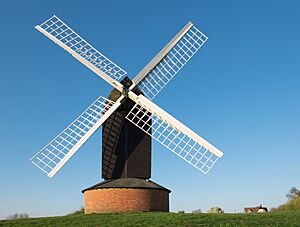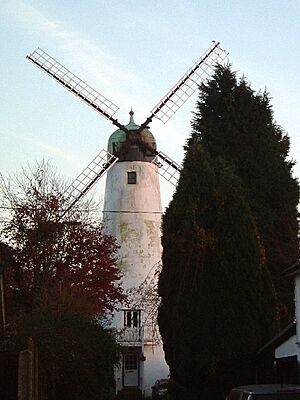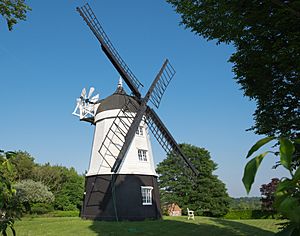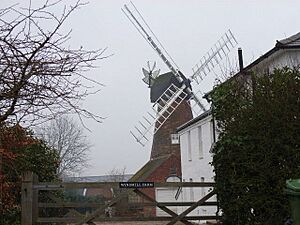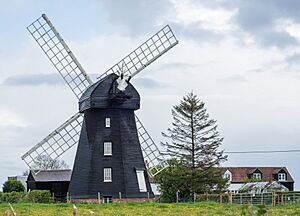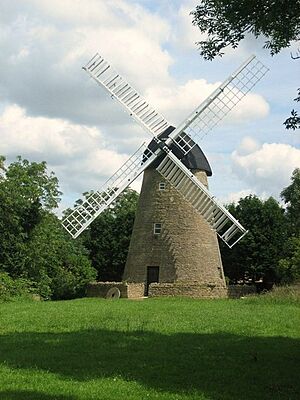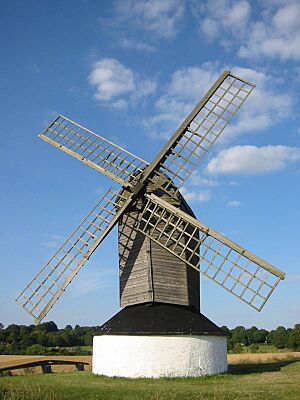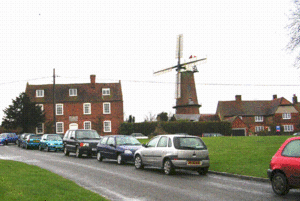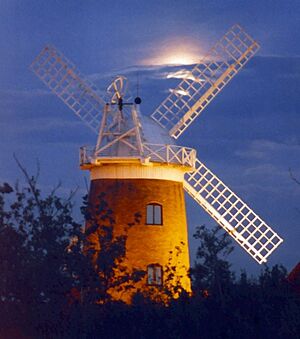List of windmills in Buckinghamshire facts for kids
Windmills are amazing buildings that use the power of wind to do work. For hundreds of years, they were super important for communities. They helped grind grain into flour or pump water. In Buckinghamshire, a county in England, many windmills have stood over time. Some are still standing today, showing us a cool part of history.
Windmills of Buckinghamshire
Windmills were once very common across the English countryside. They played a huge role in daily life. People relied on them to process crops and other materials. Today, many old windmills are gone. However, some have been saved and restored. They stand as reminders of a time when wind power was essential.
What are Windmills?
A windmill is a machine that converts wind energy into rotational energy. This energy can then be used for different tasks. The most common use was grinding grain to make flour. Windmills were also used for pumping water or sawing wood. They were a key part of the economy before steam engines and electricity.
Types of Windmills
There are a few main types of windmills. Each type has a different design.
Post Mill
A post mill is one of the oldest types. The entire body of the mill, which holds all the machinery, can turn. It spins on a large central post. This allows the miller to turn the sails into the wind. This design was very flexible.
Smock Mill
A smock mill looks a bit like a farmer's smock, which is a loose outer garment. It has a fixed, often octagonal, base. Only the cap (the top part) of the mill turns to face the wind. This type of mill could be much taller than a post mill.
Tower Mill
A tower mill is built from stone or brick. It has a fixed, round tower. Like the smock mill, only the cap turns to catch the wind. Tower mills were very strong and could be built quite tall. This made them good for windy locations.
Famous Windmills in Buckinghamshire
Buckinghamshire is home to several interesting windmills. Some are still standing, while others are only memories.
Brill Windmill
The Brill Windmill is a famous post mill in Brill. It was first mentioned way back in 1668. This makes it one of the oldest windmills in the county. It's a great example of how these mills looked and worked. The mill has been carefully preserved.
Cholesbury Mill
The Cholesbury Windmill is a tower mill. It was built in 1884. This mill is a good example of a later type of windmill. It shows how mill design changed over time. It stands proudly in the landscape.
Cobstone Windmill
Cobstone Windmill is a beautiful smock mill located near Ibstone. It was built around 1864. This mill is quite famous. It has even appeared in movies and TV shows! It's a popular landmark in the area.
Coleshill Windmill
Grove's Mill in Coleshill is a tower mill. It was first mentioned in 1856. This mill is another example of the strong tower design. It shows the importance of windmills in local communities.
Lacey Green Windmill
The Lacey Green Windmill is a smock mill. It has a unique story. It was originally built in Chesham around 1650. Then, in 1821, it was moved to Lacey Green! This was a huge effort. It is now one of the oldest smock mills in the country.
New Bradwell Windmill
The New Bradwell Windmill is a tower mill. It was built in 1864. This mill stands tall in New Bradwell. It represents the industrial heritage of the area.
Pitstone Windmill
Pitstone Windmill is a very old post mill. It dates back to the 17th century. It is one of the oldest surviving windmills in Britain. It has been restored and is now cared for by the National Trust. It offers a glimpse into the past.
Quainton Windmill
Banner Mill in Quainton is a tower mill. It was built in 1830. This impressive mill is a local landmark. It shows the strong construction of tower mills.
Caldecotte Mill (Mock Mill)
The Caldecotte Mill in Milton Keynes is a bit different. It's a tower mill built in 1990. However, it wasn't built to grind grain. It was built as part of a pub and restaurant! It looks like a traditional windmill but serves a modern purpose.
Windmills Today
Many windmills in Buckinghamshire no longer stand. Some were destroyed by fire or storms. Others were simply taken down as new technologies arrived. The remaining windmills are important historical sites. They help us understand how people lived and worked long ago. They are also beautiful parts of the landscape.
Images for kids


